Walk 14: The Burnhams
- walkingnorfolkschu
- May 14, 2024
- 8 min read
Updated: Jul 3, 2024
The Burnhams are synonymous with two things: Horatio Nelson and second-homers. Nelson was born in Burnham Thorpe on 20 September, 1758, and his memory looms large, as befits a national hero. Burnham Market, the largest of these settlements, has been dubbed Chelsea-on-Sea, such is its attraction for affluent Londoners looking to escape the big smoke at weekends.
There were once nine parishes in this cluster of villages around the River Burn, a mile or so inland from the coast. That five parish churches still function to this day is impressive, and makes for an excellent, short walk. If you include the Roman Catholic church in Burnham Market – and there’s no reason why you shouldn’t – it’s a church for every mile.

Burnham Thorpe
I started at All Saints, Burnham Thorpe, where the Revd Edmund Nelson was Rector from 1755 until his death in 1802. His is Norfolk’s most famous son, and wherever you look there are Nelson memorabilia and monuments. This includes a very plain wooden lectern. You have to get down on your hands and knees to read the plaque, which reveals it was carved from the wood of HMS Victory.
I was told that a visitor the previous day had walked through the door, saluted, and walked back out again. This is a shame, as this church, which could so easily be a shrine to Nelson and nothing else, is beautiful and prayerful. An early twentieth century rood beam bears a lone crucifix, and the simple inscription in gold leaf, ‘God so loved the world.’

Interior, Burnham Thorpe
In the north aisle is framed the ‘Prayer Before The Battle’ Nelson wrote on the morning of his death. ‘I commit my life to him who made me, and may his blessing light upon my endeavours for serving my country faithfully.’ A reminder, feet away from the font in which he was baptised, that Nelson was first a child of God.
In the churchyard I met a fascinating gentleman – I didn’t catch his name – who is responsible for the fabric here. He is a (non-observant) Jew who loves churches. He is very glad to volunteer, having retired from a role in agricultural economics (if I remember correctly), but has been amazed at the complexity of church governance. The glacial nature of faculty jurisdiction he finds particularly irksome. ‘In my professional life we just got things done.’ It is interesting talking to someone whose experience comes from ‘outside’ the church. He is genuinely concerned about the future of churches like this, relying on a dwindling and ageing band of volunteers, with increasing demands from ‘headquarters’. This conversation stayed with me for the whole walk.
Following footpaths through fields of hares, deer and pheasants – now everyday sights for me – I joined the Creake road into the town of Burnham Market. First stop, the ruins of St Ethelbert, Burnham Sutton. The ivy-clad base of the walls of the nave and tower are all that remain. Nelson’s father, faced with two dilapidated church buildings within 500 yards of each other, sought permission to demolish this building in 1766 so he could restore the other.
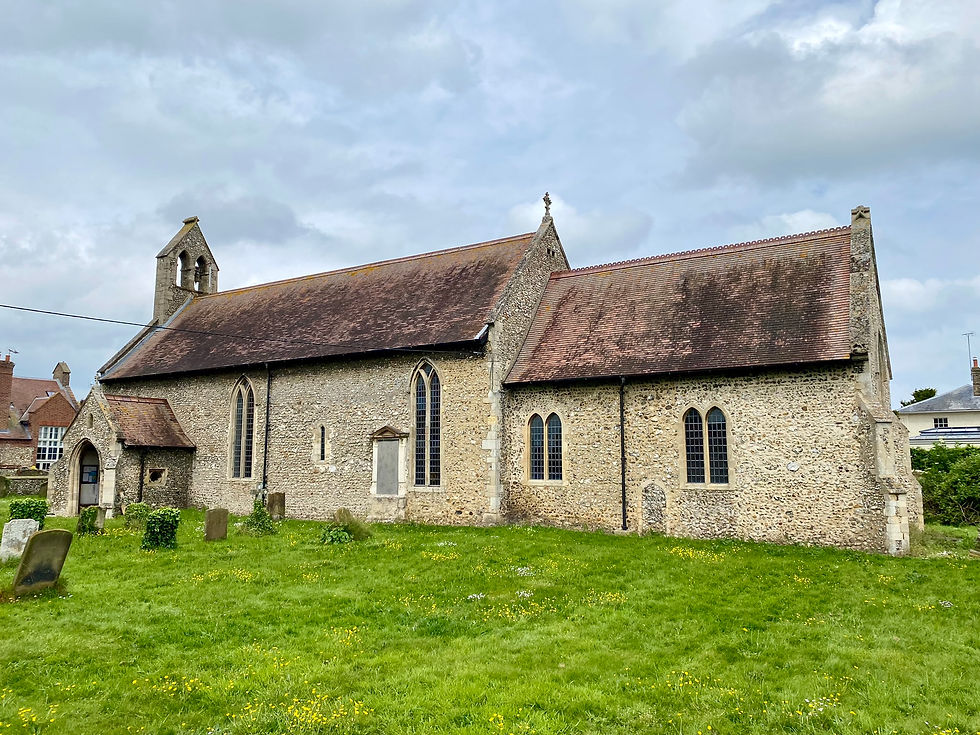
All Saints, Burnham Sutton cum Ulph
A minute’s walk away, therefore, is All Saints, Burnham Sutton cum Ulph (or just Burnham Ulph before the parishes were amalgamated). A simple church, with an interesting, transitional chancel arch. The capitals are Norman, but support an Early English arch. Chunks have been crudely removed from the capitals to accommodate a long-gone rood screen. Clearly there was no faculty jurisdiction in the Middle Ages!
The benefice here has a wonderfully simple service pattern. The 8am and 10am service both take place in a different church each Sunday. So many rural benefices have the most complex tables in the porch, leaving the visitor clueless as to what happens where. Here, as long as you don’t confuse your Nortons with your Ulphs, and your Westgates for your Overy Towns, it’s all refreshingly clear. And it probably encourages cross-fertilisation between the different churches.
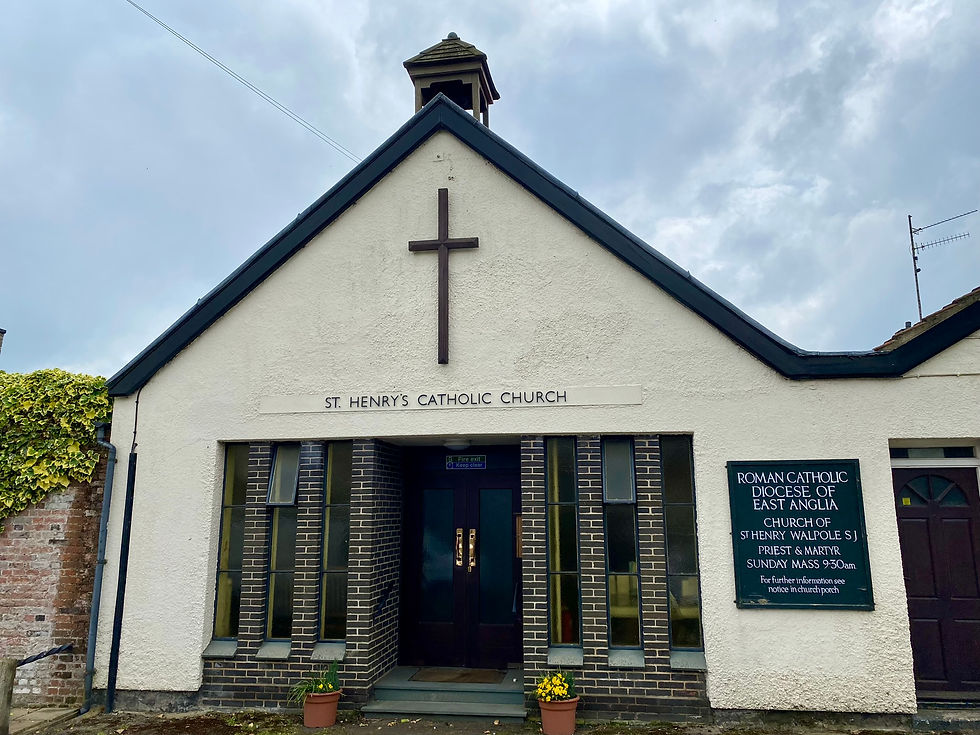
St Henry Walpole, Burnham Market
At the other end of the high street is the Roman Catholic Church of St Henry Walpole, Burnham Market. It’s not much more than a mission hut, but open and prayerful. Henry was born in nearby Docking, and became a Jesuit in 1588. When he returned from the continent in 1593, he was arrested and imprisoned in the Tower of London. We was martyred at York in 1595, and canonised in 1970 as one of the Forty Martyrs of England and Wales. The church has a relic, and this was a good place to pray for the unity of Christ’s church.
Across the road is St Mary, Burnham Westgate. The glory of this church is the richly decorated battlements on the tower. They show an array of Biblical scenes, including the Annunciation and Visitation on the south side, and a narrative of the death of John the Baptist on the north and west sides. John carries his head, while Salome dances at Herod’s table.
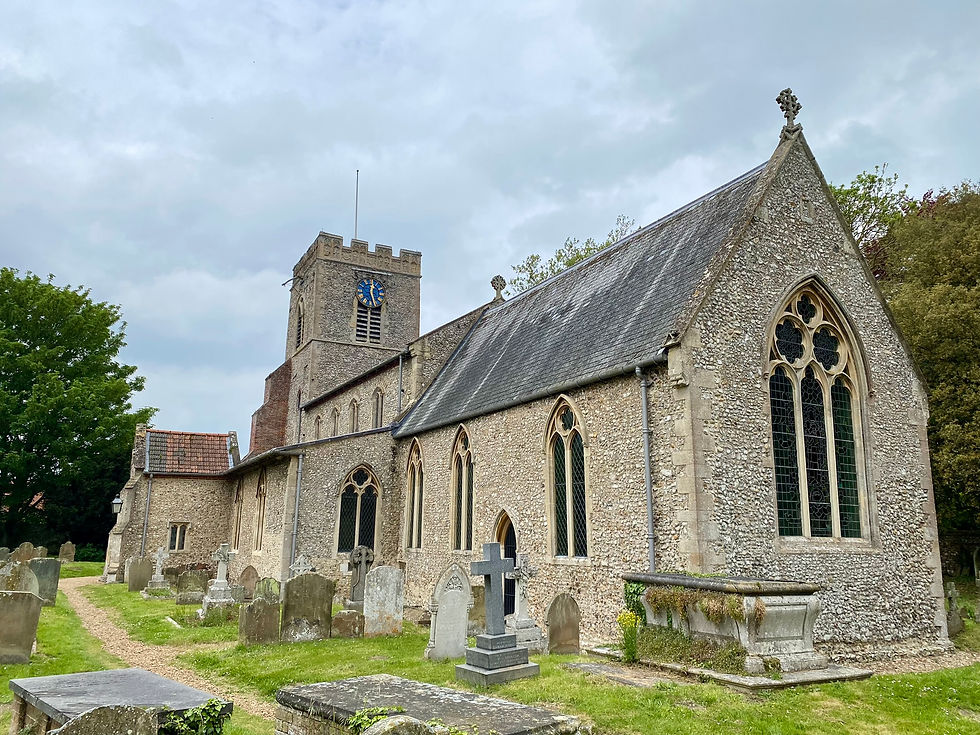
St Mary, Burnham Westgate
This benefice has been vacant for at least a couple of years. The parish profile when it was first advertised included a bold vision to transform this church into a cultural venue, but, apart from some plans on a noticeboard under the tower, nothing seems to have happened. That have something to do with the failure to appoint a parish priest. The Diocese managed to attract some funding from the Prayer Book Society to make this a full-time post, which was then readvertised, but I’ve not heard of an appointment. Clergy recruitment is clearly a massive problem in this diocese.
I ate my lunch in the churchyard, and was joined by a landscape gardener (and his dog) who is contracted to mow the lawns along the high street. He’s from Tilney All Saints, which I visited last month. We had an interesting conversation about Norfolk people, of which he is one, and how open and friendly they are. Later, as I left the churchyard, a family was playing on the green, and he was letting a small child have a go on his sit-on lawnmower.
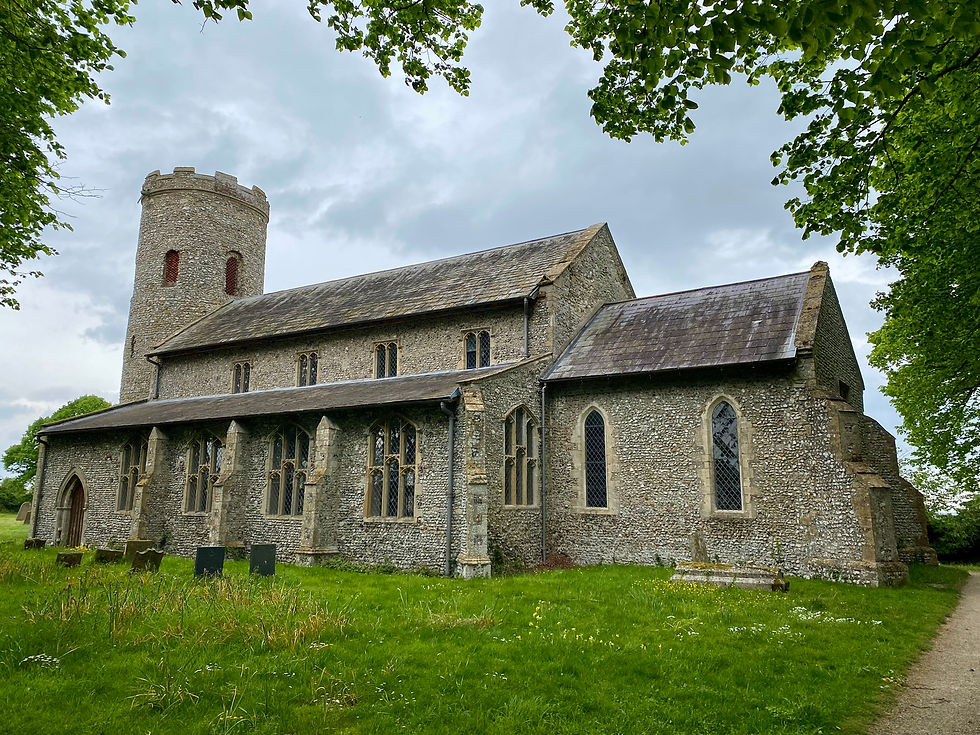
Burnham Norton
By far my favourite of the Burnham churches is St Margaret, Burnham Norton, with its Norman round tower, standing above and apart from the village. From the north porch there are fine views of saltmarsh and sea, and the windmill at Burnham Overy Staithe. The setting is idyllic.
As I arrived an American couple who live in Tufnell Park were leaving. This was a day of long conversations! Anita was a child psychologist before she retired. She had worked with many victims and survivors of child abuse, including abuse suffered in church contexts. She reminded me that many people’s only experience of the Christian church is through its failings in safeguarding. ‘You’ve restored my faith a bit,’ she told me. I’m not sure how, but I’m glad if that’s the case. They were fascinated by my project, and asked lots of questions.

Burnham Norton's font
Inside, the nave has screens to the north, south and west as well as the east, creating a homely church within a church. The Norman font has different decoration on each of its four sides. There are not one, but two pulpits. One is Jacobean. The other is a stunning wineglass pulpit of 1450, similar in style to Castle Acre’s yesterday. In addition to the Four Doctors of the Church is a panel portraying the donors. You can imagine a ‘battle of the pulpits’, but you’d need to be as light as a feather to stand in the older one.
Before I left, Anita’s husband (alas, I can’t remember his name) returned, wanting advice about which churches they should visit before their holiday ended. They had clearly got to the car and thought I was a mine of information worth quarrying! I’m not very good at being put in the spot, but said they couldn’t go wrong with Cley, Binham and Walsingham.
A footpath leads east to the side of Burnham Market Primary School. This 1970s building looks like it belongs in the suburbs of Norwich, or Tufnell Park, not in an Area of Outstanding Natural Beauty. (I have to be careful what I say; my mother-in-law used to teach here.)

The gatehouse of St Mary's Friary
Opposite the school entrance are the remains of St Mary’s Friary, Burnham Norton. Carmelites were here until the Reformation. In another case of the scandal of our forebears, one friar was hung, drawn and quartered in King’s Lynn for planning an uprising against the closure of the friary.
The gatehouse remains perfectly intact, as does the west gable of the church. A passer-by told me that the 1950s re-roofing used tiles which are too heavy, and it needs a lighter roof. The whole friary was really quite small, especially when you compare it to Binham and Walsingham. There are similarly small ruins at Creake Abbey to the south, and Peterstone Farm to the east. There must have been a real hubbub of religious life in these parts.
Next to the ruins, on private land, is ‘Our Lady’s Well’. Back in St Margaret’s is a prayer-poem by Kevin Crossley-Holland, which ‘adopts the idea that Jesus Himself is embodied in the continuous flow of clear water and the landscape surrounding it, and that we as human beings should learn from Him and pray that we may follow his example’. Perhaps I should contact him to see if I can reproduce the poem here. Or you can go to Burnham Norton and read it for yourself.

St Clement, Burnham Overy Town
The final church of the day was St Clement, Burnham Overy Town. Like Burnham Thorpe, this is a village distinct from Burnham Market, but part of the same benefice. ‘This is a church,’ Mortlock writes, ‘whose history and fabric raise enough questions and intriguing puzzlements to make one dizzy.’ The Norman tower, with its little cupola, creates a partition between the nave and chancel more definite than in many a cathedral. There’s a south aisle, but no north aisle, and, as you walk around the exterior, you can see where transepts and aisles and doorways and windows have been demolished or rebuilt.
The churchwarden, treasurer and keyholder here is Bridget Bunkle. I recall meeting her when I first visited this church in 2017. (Hers is a name not easily forgotten.) Judging from the notices in the church, there have been problems with visitors not turning the tap off in the loo, which is now kept locked. It was another reminder of the burdens of rural church life.
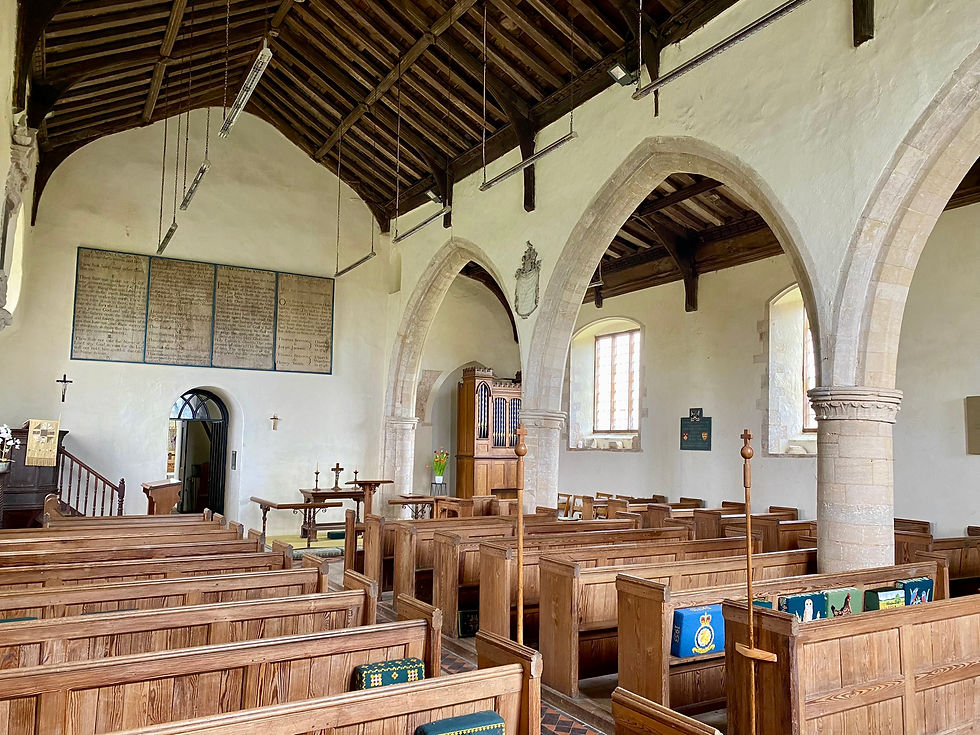
The nave, St Clement, Burnham Overy Town
I was struck here by the number of tasteful monuments to past worshippers in the latter part of the twentieth century: architects, judges, embroiderers, and the like. I wonder if there was a golden age of retirees in these parts; people who came here with time, talent, and a willingness to get involved in church life. The gentleman at Burnham Thorpe, whose words were still ringing in my ears, is in this vein, although not himself a Christian. But how many more are there like him? Not many, I fear.
This was a day of beautiful, well-kept churches, and several delightful chance-encounters. But I couldn’t shake off a feeling of unease about the future. There is a lot of money in the Burnhams, but not much of it is being spent here. In the last few years both the pharmacy and the excellent bookshop have closed. How much longer can it sustain this number of churches for a shrinking resident population?
Walk: 6.5 miles https://explore.osmaps.com/route/21547907/burnhams





Comments